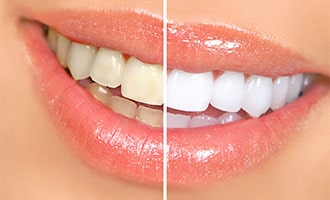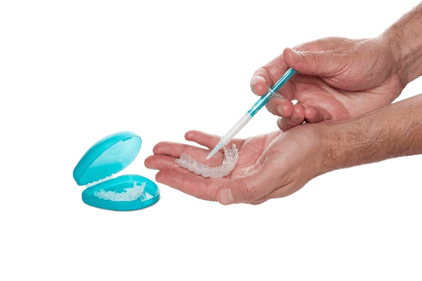
If your teeth are not as white as you would like, maybe thanks to a love of coffee, tea or wine, or due to the effects of aging, you could benefit from teeth whitening treatment with Dr. Ashwini Bhave. Teeth whitening treatment lifts stains and improves the color of your teeth so your smile looks whiter, brighter and healthier.
Why Choose a Professional for Teeth Whitening
Have you used drugstore whitening strips or toothpastes but not seen the results you desire? Over-the-counter options are simply not strong enough to penetrate the teeth and remove stains below the surface of the enamel. Certain products, like generic whitening trays and strips, are also prone to slipping, sliding and leaking, causing teeth sensitivity and/or gum irritation. Uneven or patchy results are another common problem with over-the-counter products.
When you trust your teeth whitening treatment to Dr. Bhave, you can expect a totally new experience. Treatment is fast and comfortable, and the results are even and noticeable. Even tough stains look lighter, thanks to professional bleaching agents. Dr. Bhave takes the proper precautions so you do not experience sensitivity or other uncomfortable side effects from whitening treatment. Dr. Bhave also provides the information you need to ensure your results last as long as possible.
Teeth Whitening Procedure Details
In-Office Teeth Whitening
You have several teeth whitening options with Dr. Bhave. If you want fast results, you may opt for a short, in-office whitening treatment. If you prefer to whiten in the comfort of your own home, Dr. Bhave can provide customized trays with a powerful whitening gel.

In-office whitening lifts stains and brightens your smile in as little as one hour. To begin, a protective barrier is placed over your gums to protect them from the whitening gel, and a desensitizing agent is applied to the teeth to reduce discomfort. Then, a powerful whitening gel is applied to your teeth to break up stains and improve the teeth’s overall color. The gel may be activated with a special light and wiped off and reapplied several times throughout the process. You will leave the office with a noticeably whiter and more beautiful smile.
At-Home Teeth Whitening
At-home whitening allows you to treat stains and discoloration at home or while traveling. You will be fitted for custom trays made to fit snugly and comfortably around your teeth. Dr. Bhave selects the whitening gel that will give you the results you want with the least amount of sensitivity. She also provides instructions regarding how to place the gel in the trays and how long to wear the trays. Results can be seen within a few weeks.
Porcelain Veneers as an Alternative to Teeth Whitening
Dr. Bhave offers one more option for improving the color of your teeth. If you have stains or discoloration that do not respond to whitening treatment, or if you are looking for permanently white teeth, she can place beautiful porcelain veneers over the teeth that show when you smile. Veneers can also change the shape of the teeth along with their color for the best aesthetic results.
Your veneers will be completely customized to the unique characteristics of your smile and face. They will blend in with your existing teeth and flatter your hair and eye color. Today’s veneers are stronger and more durable than ever, so you can enjoy your picture-perfect smile for many years.
Maintaining Your Smile After Professional Whitening Treatment
It is natural for teeth to become stained over time due to lifestyle factors, diet, and even certain medications. While some causes of tooth discoloration are outside patients’ control, you should aim to limit your exposure to those factors that can be controlled. To keep your smile as white as possible, consider minimizing your consumption of heavily pigmented foods and beverages. You should also avoid smoking. In addition, because stains can cling to plaque, regular brushing and flossing to eliminate this sticky film of bacteria on the teeth can give you a brighter smile.
The results of whitening can begin to fade over time. Patients can opt for follow-up whitening treatments if they notice stains or discoloration.
Managing Sensitivity During Treatment
Dr. Bhave is dedicated to providing excellent patient care. She takes many steps to ensure that patients have a comfortable experience while getting their teeth whitened. These may include:
Desensitizing products: Certain products may be used during treatment that reduce or eliminate sensitivity.
Using a lower concentration: Higher concentrations of the whitening agent can lead to sensitivity in some patients. As such, Dr. Bhave may recommend an adjustment to the concentration that still yields beautifully white results.
Shorter whitening sessions: Undergoing shorter professional teeth whitening treatments has a two-pronged benefit in that it reduces the chance you will experience tooth sensitivity while also allowing you to get back to your normal routine even sooner.
Carefully planned sessions: If you have a certain whitening goal, you may need several sessions to achieve your desired result. However, this can result in sensitivity if these sessions occur in quick succession. Dr. Bhave will plan your sessions appropriately so that you do not experience unnecessary discomfort.
Whitening Toothpaste
Patients who are interested in achieving a brighter smile have likely considered at-home methods that claim to produce great results. One such method is whitening toothpaste, but not all options are equal. Whitening toothpaste can contain whitening agents and abrasives, which can produce undesirable effects on the tissues and enamel of the teeth. If you are considering a whitening toothpaste to maintain your white smile between treatments, consider one that is recommended for daily use and contains the ADA Seal of Acceptance, which indicates to consumers that the product has been evaluated for efficacy and safety. Additionally, Dr. Bhave can recommend specific options for your unique needs.
When To Get Professional Whitening Treatments
Teeth whitening is a cosmetic treatment that is used to make your smile look better. It is generally recommended that you have whitening services performed after restorative procedures. For example, if you have gum disease, Dr. Bhave may recommend that you undergo periodontal treatment ahead of time. Gum disease and other dental issues can affect cosmetic treatments, which is why your oral health is prioritized before cosmetic treatments are performed.
Professional Whitening Cost
Costs for professional teeth whitening can vary based on whether you receive care in-office, use at-home teeth whitening kits, and a variety of other factors. Contact us today to learn more about what you can expect to pay for whitening treatments.
Teeth Whitening FAQs
Is there a difference between bleaching and whitening?
While the U.S. Food and Drug Administration regulates each of these terms, the FDA actually sets a higher standard for products that advertise “bleaching.” Bleaching products must contain a chemical bleach such as hydrogen peroxide or carbamide peroxide. As a result, the term “whitening” is used more frequently to describe products and treatments because it sounds both gentler and more effective.
The whitening treatment you receive at Bay Area Dental Specialists will involve bleaching, with help from hydrogen peroxide at a 9 to 40 percent concentration. The take-home teeth whitening kits we offer feature carbamide peroxide, which is about one-third the strength that you would receive from a hydrogen peroxide treatment.
What makes teeth lose their sparkle?
As your age increases and your health declines, it is common to notice your teeth become less white. That happens because the protective enamel on the surface of your teeth gradually erodes. Although the different color beneath the enamel is natural to most teeth, it is obviously not the shiny white shade that most people want to present to the world.
For most people, the color beneath the enamel is yellowish, though some people have teeth that look more brown or greenish-gray in color. The precise color is generally determined by genetics, though a diet heavy in sugary and acidic foods can stain your teeth further.
Another genetic consideration that can play a role is the thickness of your teeth. Teeth that are thinner than average tend to lose their shine more quickly, and can also be more difficult to whiten with common treatments.
What causes staining?
Certain foods and drinks that you enjoy can take a toll on the color of your teeth, particularly if you consume them regularly. In addition to dark-colored beverages such as tea, coffee, red wine and cola, vinegar and vegetables that are high in acid can contribute to the erosion of tooth enamel. Smoking is another habit that can severely yellow the teeth.
While the majority of tooth staining is tied to your diet and hygiene, some discoloration can be caused by factors beyond your own control. Ingesting too much fluoride as a young child can cause permanent brown or dark gray stains on the interior of your teeth. Furthermore, if your mother used tetracycline antibiotics while your teeth were developing, that may have caused similar stains to form.
For patients in San Jose, Los Gatos, Campbell and surrounding areas, regular cleanings at Bay Area Dental Specialists will help to prevent your surface stains from becoming permanent blemishes on your dentin. If you are interested in whiter teeth, speak to our experts about whitening solutions — both in-office and at-home — to renew the quality of your smile.
For more information about teeth whitening with Dr. Bhave, please call or email our practice today.



